Strategic Management Report: Landmark Horticulture Analysis
VerifiedAdded on 2022/12/19
|12
|2786
|4
Report
AI Summary
This report provides a comprehensive strategic analysis of Landmark Horticulture within the Australian horticulture sector, exploring its potential in the international market. The report begins with an executive summary, table of contents, and introduction, highlighting the sector's growth and competitive landscape. It identifies key international opportunities for Landmark Horticulture, such as the increasing global demand for natural products and the economic development in emerging markets. The report recommends a multi-domestic strategy, complemented by a global strategy for standardized services. It evaluates foreign direct investment and joint ventures as appropriate modes of entry, while dismissing direct exporting and franchising due to the nature of the horticulture products. The report concludes with recommendations for future strategic direction, emphasizing business diversification, market penetration, and targeting developing countries like China. The report incorporates academic writing guidelines, Harvard referencing, and a minimum of eight journal articles and textbook references.
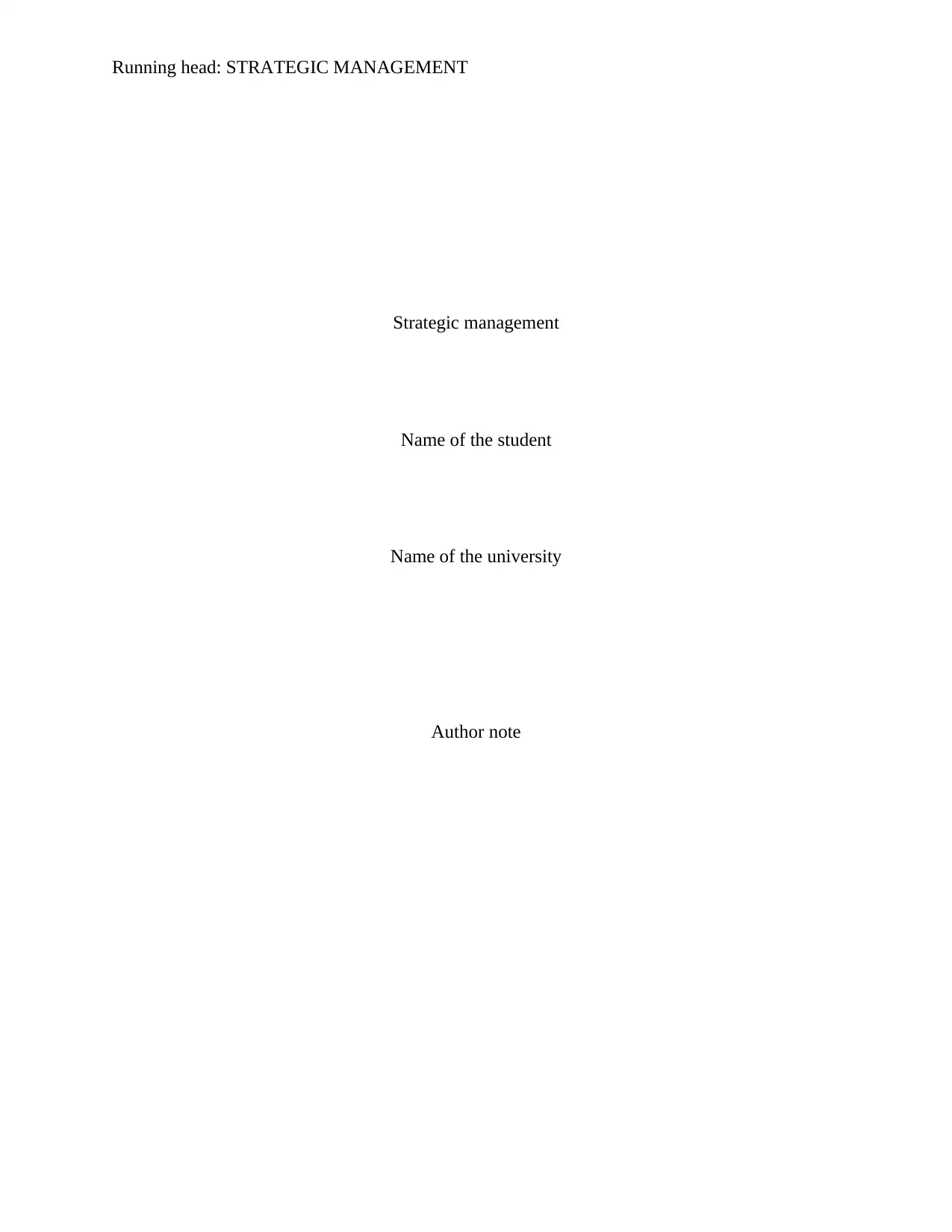
Running head: STRATEGIC MANAGEMENT
Strategic management
Name of the student
Name of the university
Author note
Strategic management
Name of the student
Name of the university
Author note
Paraphrase This Document
Need a fresh take? Get an instant paraphrase of this document with our AI Paraphraser
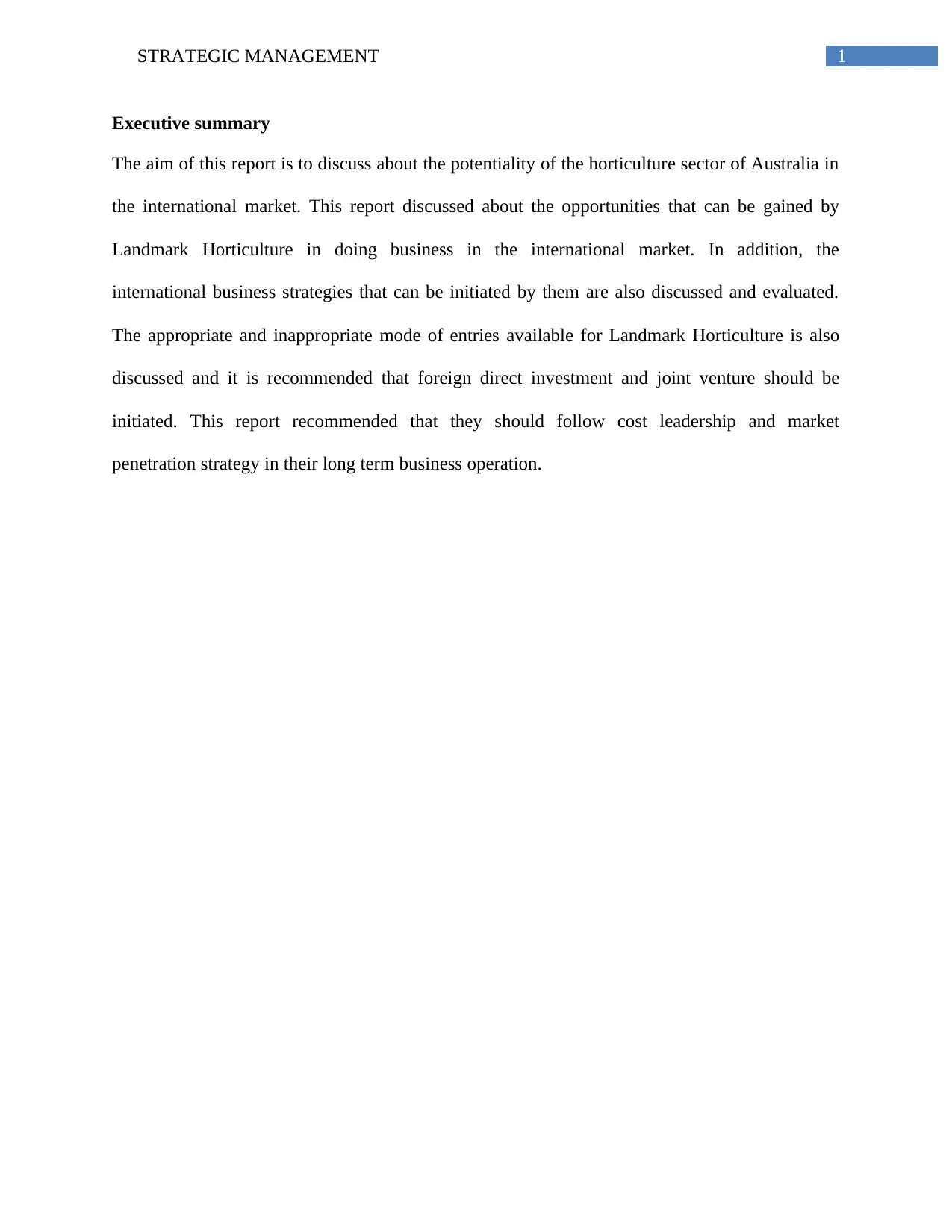
1STRATEGIC MANAGEMENT
Executive summary
The aim of this report is to discuss about the potentiality of the horticulture sector of Australia in
the international market. This report discussed about the opportunities that can be gained by
Landmark Horticulture in doing business in the international market. In addition, the
international business strategies that can be initiated by them are also discussed and evaluated.
The appropriate and inappropriate mode of entries available for Landmark Horticulture is also
discussed and it is recommended that foreign direct investment and joint venture should be
initiated. This report recommended that they should follow cost leadership and market
penetration strategy in their long term business operation.
Executive summary
The aim of this report is to discuss about the potentiality of the horticulture sector of Australia in
the international market. This report discussed about the opportunities that can be gained by
Landmark Horticulture in doing business in the international market. In addition, the
international business strategies that can be initiated by them are also discussed and evaluated.
The appropriate and inappropriate mode of entries available for Landmark Horticulture is also
discussed and it is recommended that foreign direct investment and joint venture should be
initiated. This report recommended that they should follow cost leadership and market
penetration strategy in their long term business operation.
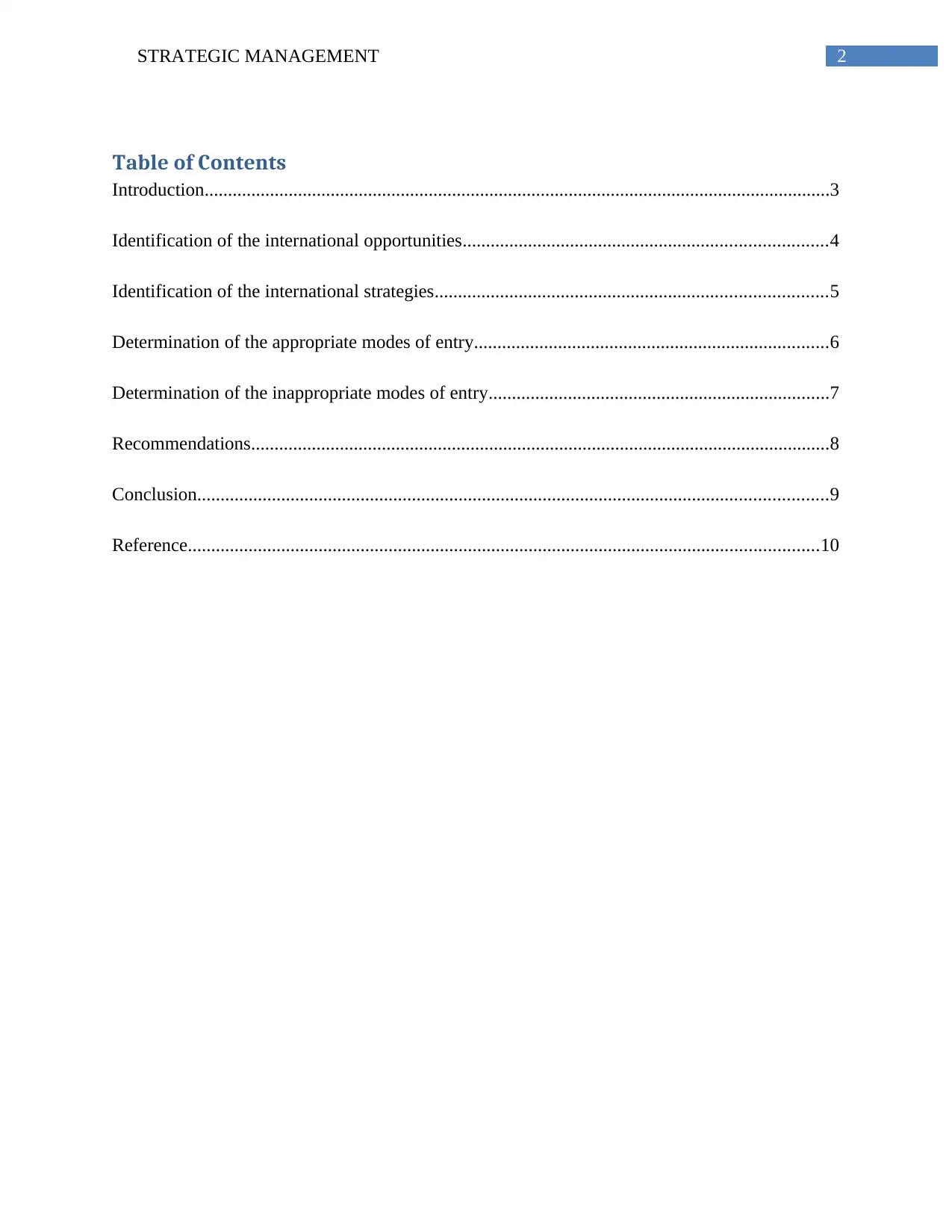
2STRATEGIC MANAGEMENT
Table of Contents
Introduction......................................................................................................................................3
Identification of the international opportunities..............................................................................4
Identification of the international strategies....................................................................................5
Determination of the appropriate modes of entry............................................................................6
Determination of the inappropriate modes of entry.........................................................................7
Recommendations............................................................................................................................8
Conclusion.......................................................................................................................................9
Reference.......................................................................................................................................10
Table of Contents
Introduction......................................................................................................................................3
Identification of the international opportunities..............................................................................4
Identification of the international strategies....................................................................................5
Determination of the appropriate modes of entry............................................................................6
Determination of the inappropriate modes of entry.........................................................................7
Recommendations............................................................................................................................8
Conclusion.......................................................................................................................................9
Reference.......................................................................................................................................10
⊘ This is a preview!⊘
Do you want full access?
Subscribe today to unlock all pages.

Trusted by 1+ million students worldwide
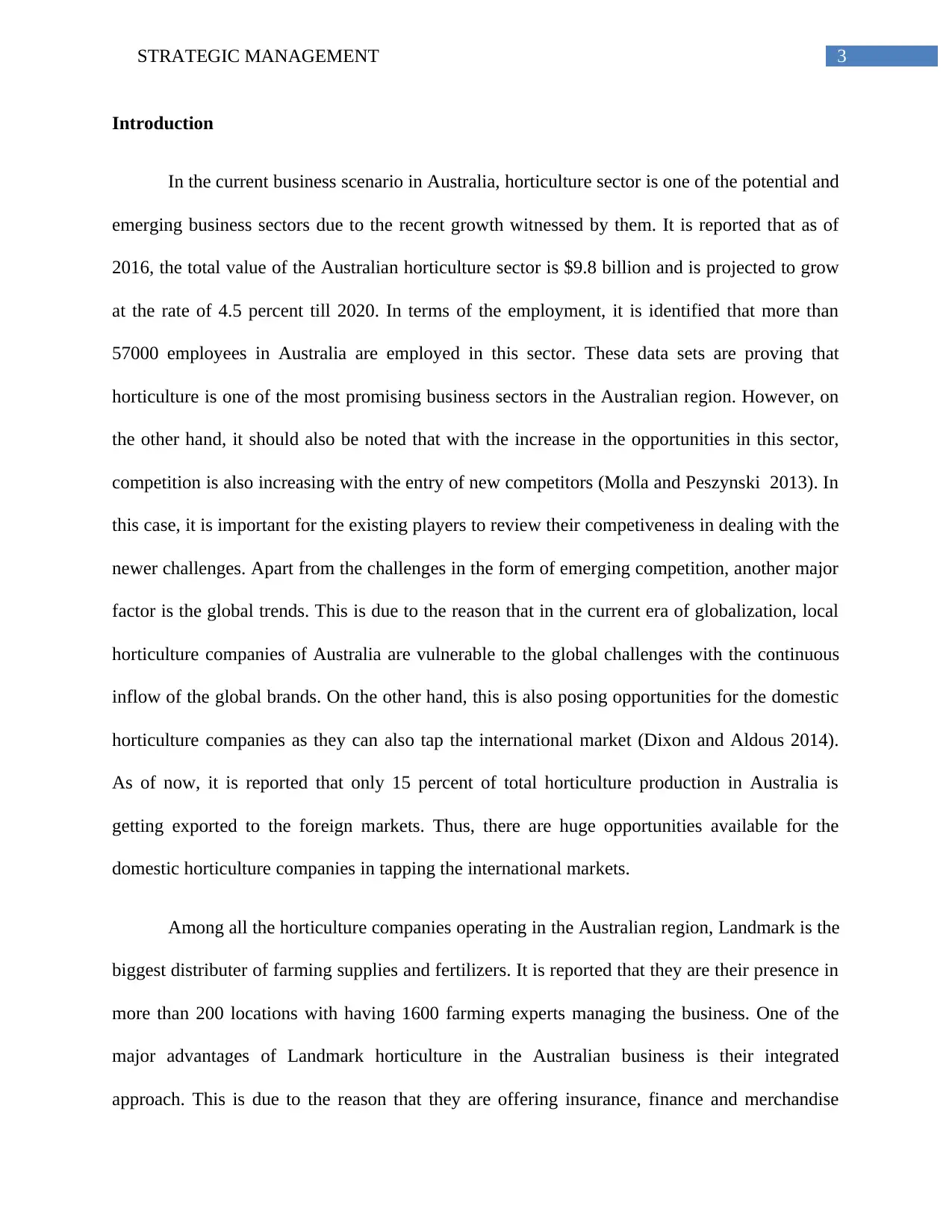
3STRATEGIC MANAGEMENT
Introduction
In the current business scenario in Australia, horticulture sector is one of the potential and
emerging business sectors due to the recent growth witnessed by them. It is reported that as of
2016, the total value of the Australian horticulture sector is $9.8 billion and is projected to grow
at the rate of 4.5 percent till 2020. In terms of the employment, it is identified that more than
57000 employees in Australia are employed in this sector. These data sets are proving that
horticulture is one of the most promising business sectors in the Australian region. However, on
the other hand, it should also be noted that with the increase in the opportunities in this sector,
competition is also increasing with the entry of new competitors (Molla and Peszynski 2013). In
this case, it is important for the existing players to review their competiveness in dealing with the
newer challenges. Apart from the challenges in the form of emerging competition, another major
factor is the global trends. This is due to the reason that in the current era of globalization, local
horticulture companies of Australia are vulnerable to the global challenges with the continuous
inflow of the global brands. On the other hand, this is also posing opportunities for the domestic
horticulture companies as they can also tap the international market (Dixon and Aldous 2014).
As of now, it is reported that only 15 percent of total horticulture production in Australia is
getting exported to the foreign markets. Thus, there are huge opportunities available for the
domestic horticulture companies in tapping the international markets.
Among all the horticulture companies operating in the Australian region, Landmark is the
biggest distributer of farming supplies and fertilizers. It is reported that they are their presence in
more than 200 locations with having 1600 farming experts managing the business. One of the
major advantages of Landmark horticulture in the Australian business is their integrated
approach. This is due to the reason that they are offering insurance, finance and merchandise
Introduction
In the current business scenario in Australia, horticulture sector is one of the potential and
emerging business sectors due to the recent growth witnessed by them. It is reported that as of
2016, the total value of the Australian horticulture sector is $9.8 billion and is projected to grow
at the rate of 4.5 percent till 2020. In terms of the employment, it is identified that more than
57000 employees in Australia are employed in this sector. These data sets are proving that
horticulture is one of the most promising business sectors in the Australian region. However, on
the other hand, it should also be noted that with the increase in the opportunities in this sector,
competition is also increasing with the entry of new competitors (Molla and Peszynski 2013). In
this case, it is important for the existing players to review their competiveness in dealing with the
newer challenges. Apart from the challenges in the form of emerging competition, another major
factor is the global trends. This is due to the reason that in the current era of globalization, local
horticulture companies of Australia are vulnerable to the global challenges with the continuous
inflow of the global brands. On the other hand, this is also posing opportunities for the domestic
horticulture companies as they can also tap the international market (Dixon and Aldous 2014).
As of now, it is reported that only 15 percent of total horticulture production in Australia is
getting exported to the foreign markets. Thus, there are huge opportunities available for the
domestic horticulture companies in tapping the international markets.
Among all the horticulture companies operating in the Australian region, Landmark is the
biggest distributer of farming supplies and fertilizers. It is reported that they are their presence in
more than 200 locations with having 1600 farming experts managing the business. One of the
major advantages of Landmark horticulture in the Australian business is their integrated
approach. This is due to the reason that they are offering insurance, finance and merchandise
Paraphrase This Document
Need a fresh take? Get an instant paraphrase of this document with our AI Paraphraser
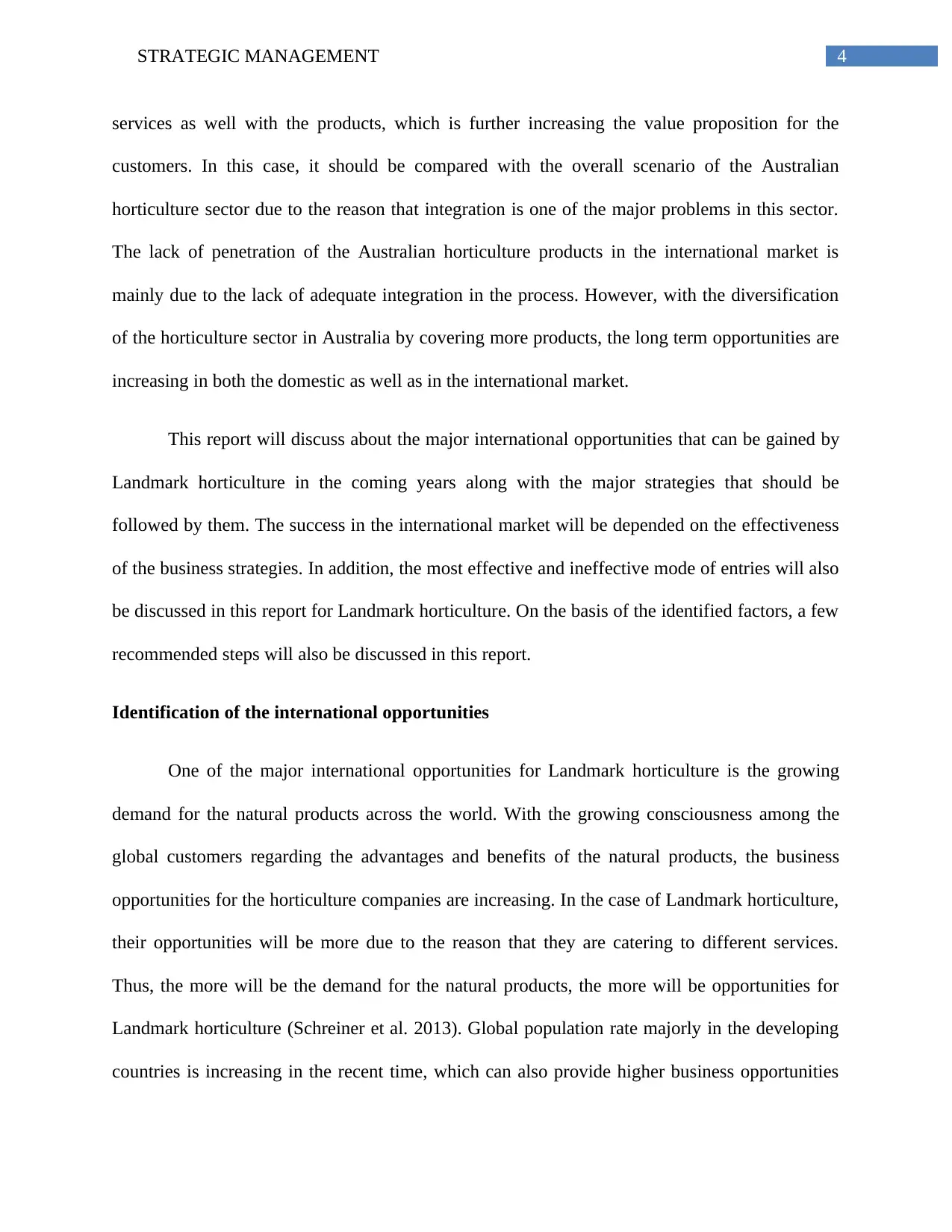
4STRATEGIC MANAGEMENT
services as well with the products, which is further increasing the value proposition for the
customers. In this case, it should be compared with the overall scenario of the Australian
horticulture sector due to the reason that integration is one of the major problems in this sector.
The lack of penetration of the Australian horticulture products in the international market is
mainly due to the lack of adequate integration in the process. However, with the diversification
of the horticulture sector in Australia by covering more products, the long term opportunities are
increasing in both the domestic as well as in the international market.
This report will discuss about the major international opportunities that can be gained by
Landmark horticulture in the coming years along with the major strategies that should be
followed by them. The success in the international market will be depended on the effectiveness
of the business strategies. In addition, the most effective and ineffective mode of entries will also
be discussed in this report for Landmark horticulture. On the basis of the identified factors, a few
recommended steps will also be discussed in this report.
Identification of the international opportunities
One of the major international opportunities for Landmark horticulture is the growing
demand for the natural products across the world. With the growing consciousness among the
global customers regarding the advantages and benefits of the natural products, the business
opportunities for the horticulture companies are increasing. In the case of Landmark horticulture,
their opportunities will be more due to the reason that they are catering to different services.
Thus, the more will be the demand for the natural products, the more will be opportunities for
Landmark horticulture (Schreiner et al. 2013). Global population rate majorly in the developing
countries is increasing in the recent time, which can also provide higher business opportunities
services as well with the products, which is further increasing the value proposition for the
customers. In this case, it should be compared with the overall scenario of the Australian
horticulture sector due to the reason that integration is one of the major problems in this sector.
The lack of penetration of the Australian horticulture products in the international market is
mainly due to the lack of adequate integration in the process. However, with the diversification
of the horticulture sector in Australia by covering more products, the long term opportunities are
increasing in both the domestic as well as in the international market.
This report will discuss about the major international opportunities that can be gained by
Landmark horticulture in the coming years along with the major strategies that should be
followed by them. The success in the international market will be depended on the effectiveness
of the business strategies. In addition, the most effective and ineffective mode of entries will also
be discussed in this report for Landmark horticulture. On the basis of the identified factors, a few
recommended steps will also be discussed in this report.
Identification of the international opportunities
One of the major international opportunities for Landmark horticulture is the growing
demand for the natural products across the world. With the growing consciousness among the
global customers regarding the advantages and benefits of the natural products, the business
opportunities for the horticulture companies are increasing. In the case of Landmark horticulture,
their opportunities will be more due to the reason that they are catering to different services.
Thus, the more will be the demand for the natural products, the more will be opportunities for
Landmark horticulture (Schreiner et al. 2013). Global population rate majorly in the developing
countries is increasing in the recent time, which can also provide higher business opportunities
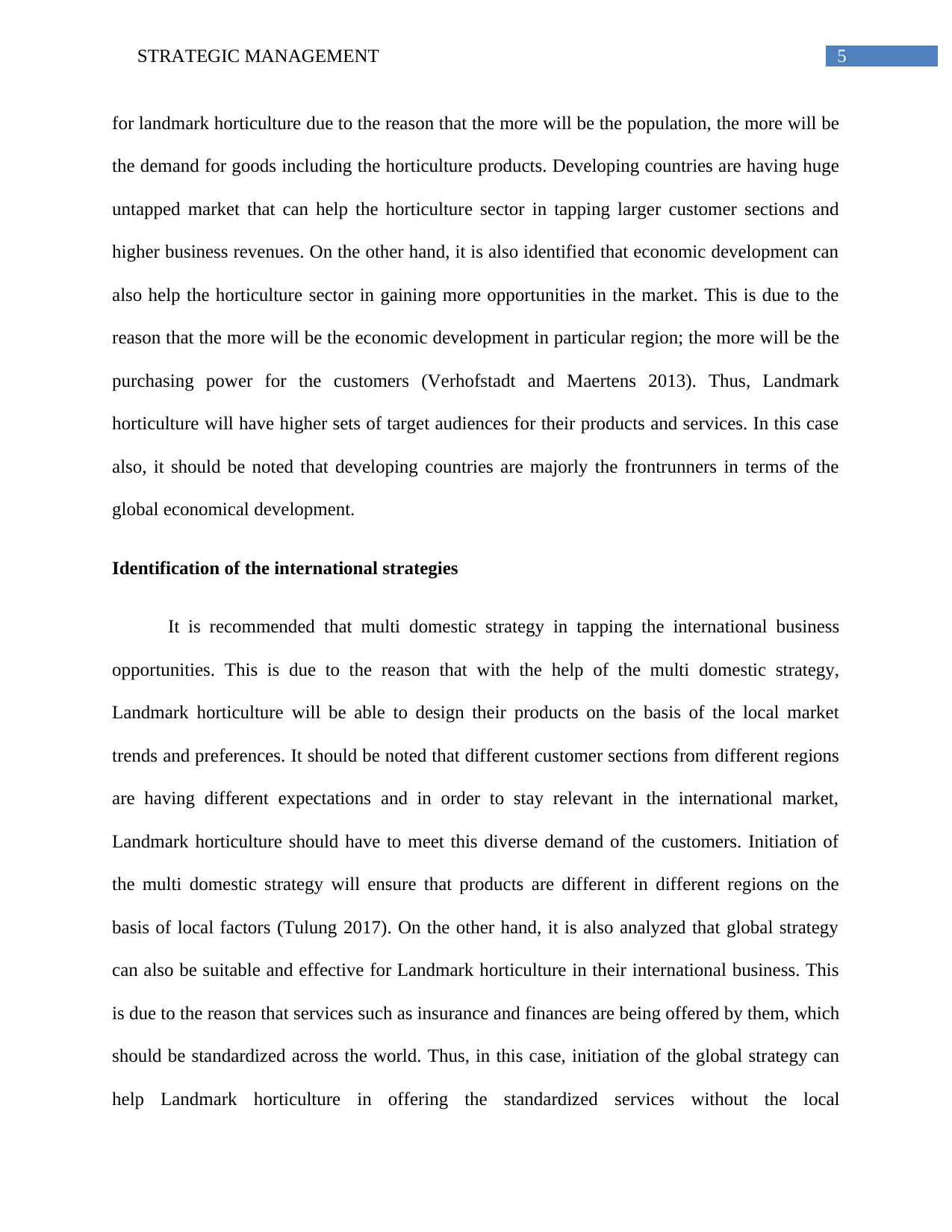
5STRATEGIC MANAGEMENT
for landmark horticulture due to the reason that the more will be the population, the more will be
the demand for goods including the horticulture products. Developing countries are having huge
untapped market that can help the horticulture sector in tapping larger customer sections and
higher business revenues. On the other hand, it is also identified that economic development can
also help the horticulture sector in gaining more opportunities in the market. This is due to the
reason that the more will be the economic development in particular region; the more will be the
purchasing power for the customers (Verhofstadt and Maertens 2013). Thus, Landmark
horticulture will have higher sets of target audiences for their products and services. In this case
also, it should be noted that developing countries are majorly the frontrunners in terms of the
global economical development.
Identification of the international strategies
It is recommended that multi domestic strategy in tapping the international business
opportunities. This is due to the reason that with the help of the multi domestic strategy,
Landmark horticulture will be able to design their products on the basis of the local market
trends and preferences. It should be noted that different customer sections from different regions
are having different expectations and in order to stay relevant in the international market,
Landmark horticulture should have to meet this diverse demand of the customers. Initiation of
the multi domestic strategy will ensure that products are different in different regions on the
basis of local factors (Tulung 2017). On the other hand, it is also analyzed that global strategy
can also be suitable and effective for Landmark horticulture in their international business. This
is due to the reason that services such as insurance and finances are being offered by them, which
should be standardized across the world. Thus, in this case, initiation of the global strategy can
help Landmark horticulture in offering the standardized services without the local
for landmark horticulture due to the reason that the more will be the population, the more will be
the demand for goods including the horticulture products. Developing countries are having huge
untapped market that can help the horticulture sector in tapping larger customer sections and
higher business revenues. On the other hand, it is also identified that economic development can
also help the horticulture sector in gaining more opportunities in the market. This is due to the
reason that the more will be the economic development in particular region; the more will be the
purchasing power for the customers (Verhofstadt and Maertens 2013). Thus, Landmark
horticulture will have higher sets of target audiences for their products and services. In this case
also, it should be noted that developing countries are majorly the frontrunners in terms of the
global economical development.
Identification of the international strategies
It is recommended that multi domestic strategy in tapping the international business
opportunities. This is due to the reason that with the help of the multi domestic strategy,
Landmark horticulture will be able to design their products on the basis of the local market
trends and preferences. It should be noted that different customer sections from different regions
are having different expectations and in order to stay relevant in the international market,
Landmark horticulture should have to meet this diverse demand of the customers. Initiation of
the multi domestic strategy will ensure that products are different in different regions on the
basis of local factors (Tulung 2017). On the other hand, it is also analyzed that global strategy
can also be suitable and effective for Landmark horticulture in their international business. This
is due to the reason that services such as insurance and finances are being offered by them, which
should be standardized across the world. Thus, in this case, initiation of the global strategy can
help Landmark horticulture in offering the standardized services without the local
⊘ This is a preview!⊘
Do you want full access?
Subscribe today to unlock all pages.

Trusted by 1+ million students worldwide
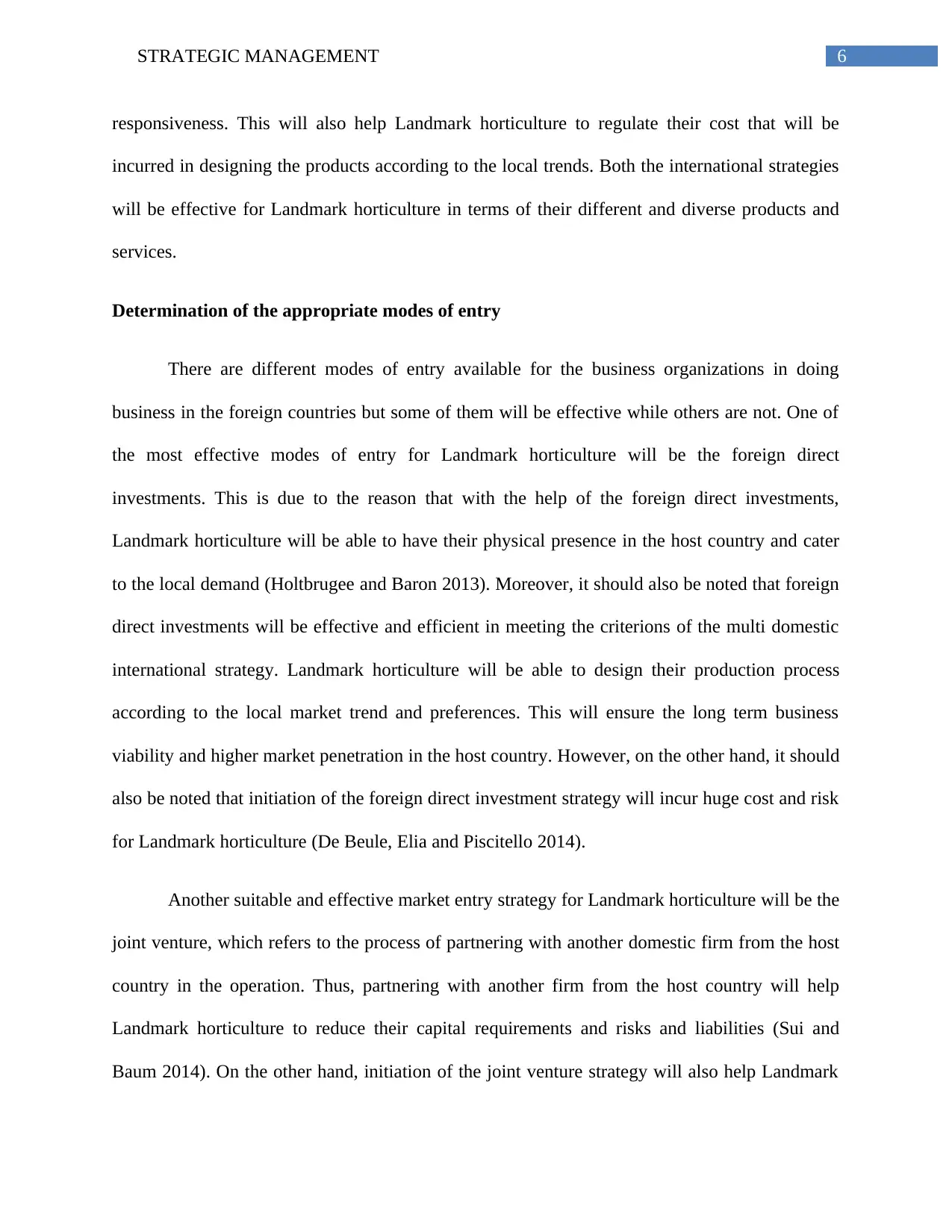
6STRATEGIC MANAGEMENT
responsiveness. This will also help Landmark horticulture to regulate their cost that will be
incurred in designing the products according to the local trends. Both the international strategies
will be effective for Landmark horticulture in terms of their different and diverse products and
services.
Determination of the appropriate modes of entry
There are different modes of entry available for the business organizations in doing
business in the foreign countries but some of them will be effective while others are not. One of
the most effective modes of entry for Landmark horticulture will be the foreign direct
investments. This is due to the reason that with the help of the foreign direct investments,
Landmark horticulture will be able to have their physical presence in the host country and cater
to the local demand (Holtbrugee and Baron 2013). Moreover, it should also be noted that foreign
direct investments will be effective and efficient in meeting the criterions of the multi domestic
international strategy. Landmark horticulture will be able to design their production process
according to the local market trend and preferences. This will ensure the long term business
viability and higher market penetration in the host country. However, on the other hand, it should
also be noted that initiation of the foreign direct investment strategy will incur huge cost and risk
for Landmark horticulture (De Beule, Elia and Piscitello 2014).
Another suitable and effective market entry strategy for Landmark horticulture will be the
joint venture, which refers to the process of partnering with another domestic firm from the host
country in the operation. Thus, partnering with another firm from the host country will help
Landmark horticulture to reduce their capital requirements and risks and liabilities (Sui and
Baum 2014). On the other hand, initiation of the joint venture strategy will also help Landmark
responsiveness. This will also help Landmark horticulture to regulate their cost that will be
incurred in designing the products according to the local trends. Both the international strategies
will be effective for Landmark horticulture in terms of their different and diverse products and
services.
Determination of the appropriate modes of entry
There are different modes of entry available for the business organizations in doing
business in the foreign countries but some of them will be effective while others are not. One of
the most effective modes of entry for Landmark horticulture will be the foreign direct
investments. This is due to the reason that with the help of the foreign direct investments,
Landmark horticulture will be able to have their physical presence in the host country and cater
to the local demand (Holtbrugee and Baron 2013). Moreover, it should also be noted that foreign
direct investments will be effective and efficient in meeting the criterions of the multi domestic
international strategy. Landmark horticulture will be able to design their production process
according to the local market trend and preferences. This will ensure the long term business
viability and higher market penetration in the host country. However, on the other hand, it should
also be noted that initiation of the foreign direct investment strategy will incur huge cost and risk
for Landmark horticulture (De Beule, Elia and Piscitello 2014).
Another suitable and effective market entry strategy for Landmark horticulture will be the
joint venture, which refers to the process of partnering with another domestic firm from the host
country in the operation. Thus, partnering with another firm from the host country will help
Landmark horticulture to reduce their capital requirements and risks and liabilities (Sui and
Baum 2014). On the other hand, initiation of the joint venture strategy will also help Landmark
Paraphrase This Document
Need a fresh take? Get an instant paraphrase of this document with our AI Paraphraser
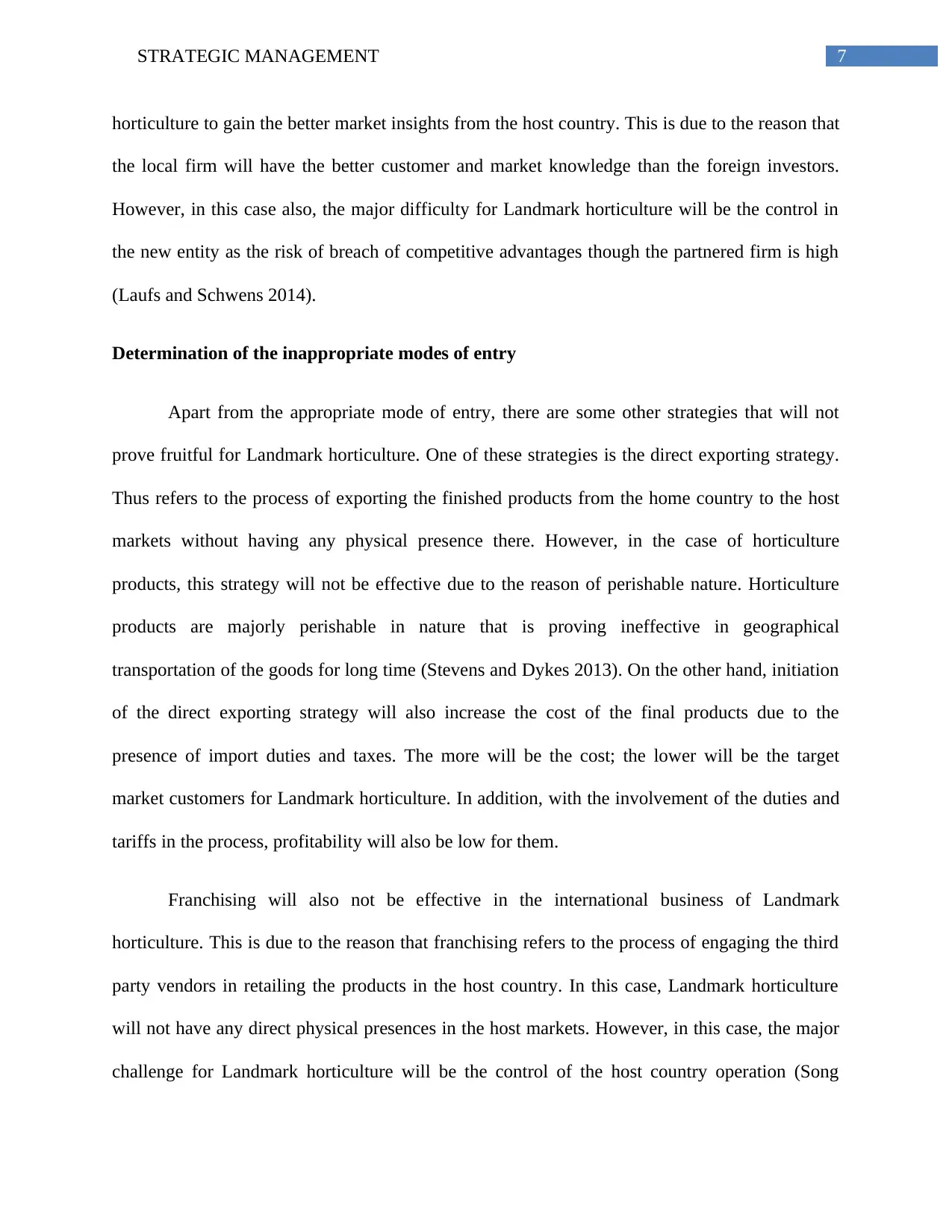
7STRATEGIC MANAGEMENT
horticulture to gain the better market insights from the host country. This is due to the reason that
the local firm will have the better customer and market knowledge than the foreign investors.
However, in this case also, the major difficulty for Landmark horticulture will be the control in
the new entity as the risk of breach of competitive advantages though the partnered firm is high
(Laufs and Schwens 2014).
Determination of the inappropriate modes of entry
Apart from the appropriate mode of entry, there are some other strategies that will not
prove fruitful for Landmark horticulture. One of these strategies is the direct exporting strategy.
Thus refers to the process of exporting the finished products from the home country to the host
markets without having any physical presence there. However, in the case of horticulture
products, this strategy will not be effective due to the reason of perishable nature. Horticulture
products are majorly perishable in nature that is proving ineffective in geographical
transportation of the goods for long time (Stevens and Dykes 2013). On the other hand, initiation
of the direct exporting strategy will also increase the cost of the final products due to the
presence of import duties and taxes. The more will be the cost; the lower will be the target
market customers for Landmark horticulture. In addition, with the involvement of the duties and
tariffs in the process, profitability will also be low for them.
Franchising will also not be effective in the international business of Landmark
horticulture. This is due to the reason that franchising refers to the process of engaging the third
party vendors in retailing the products in the host country. In this case, Landmark horticulture
will not have any direct physical presences in the host markets. However, in this case, the major
challenge for Landmark horticulture will be the control of the host country operation (Song
horticulture to gain the better market insights from the host country. This is due to the reason that
the local firm will have the better customer and market knowledge than the foreign investors.
However, in this case also, the major difficulty for Landmark horticulture will be the control in
the new entity as the risk of breach of competitive advantages though the partnered firm is high
(Laufs and Schwens 2014).
Determination of the inappropriate modes of entry
Apart from the appropriate mode of entry, there are some other strategies that will not
prove fruitful for Landmark horticulture. One of these strategies is the direct exporting strategy.
Thus refers to the process of exporting the finished products from the home country to the host
markets without having any physical presence there. However, in the case of horticulture
products, this strategy will not be effective due to the reason of perishable nature. Horticulture
products are majorly perishable in nature that is proving ineffective in geographical
transportation of the goods for long time (Stevens and Dykes 2013). On the other hand, initiation
of the direct exporting strategy will also increase the cost of the final products due to the
presence of import duties and taxes. The more will be the cost; the lower will be the target
market customers for Landmark horticulture. In addition, with the involvement of the duties and
tariffs in the process, profitability will also be low for them.
Franchising will also not be effective in the international business of Landmark
horticulture. This is due to the reason that franchising refers to the process of engaging the third
party vendors in retailing the products in the host country. In this case, Landmark horticulture
will not have any direct physical presences in the host markets. However, in this case, the major
challenge for Landmark horticulture will be the control of the host country operation (Song
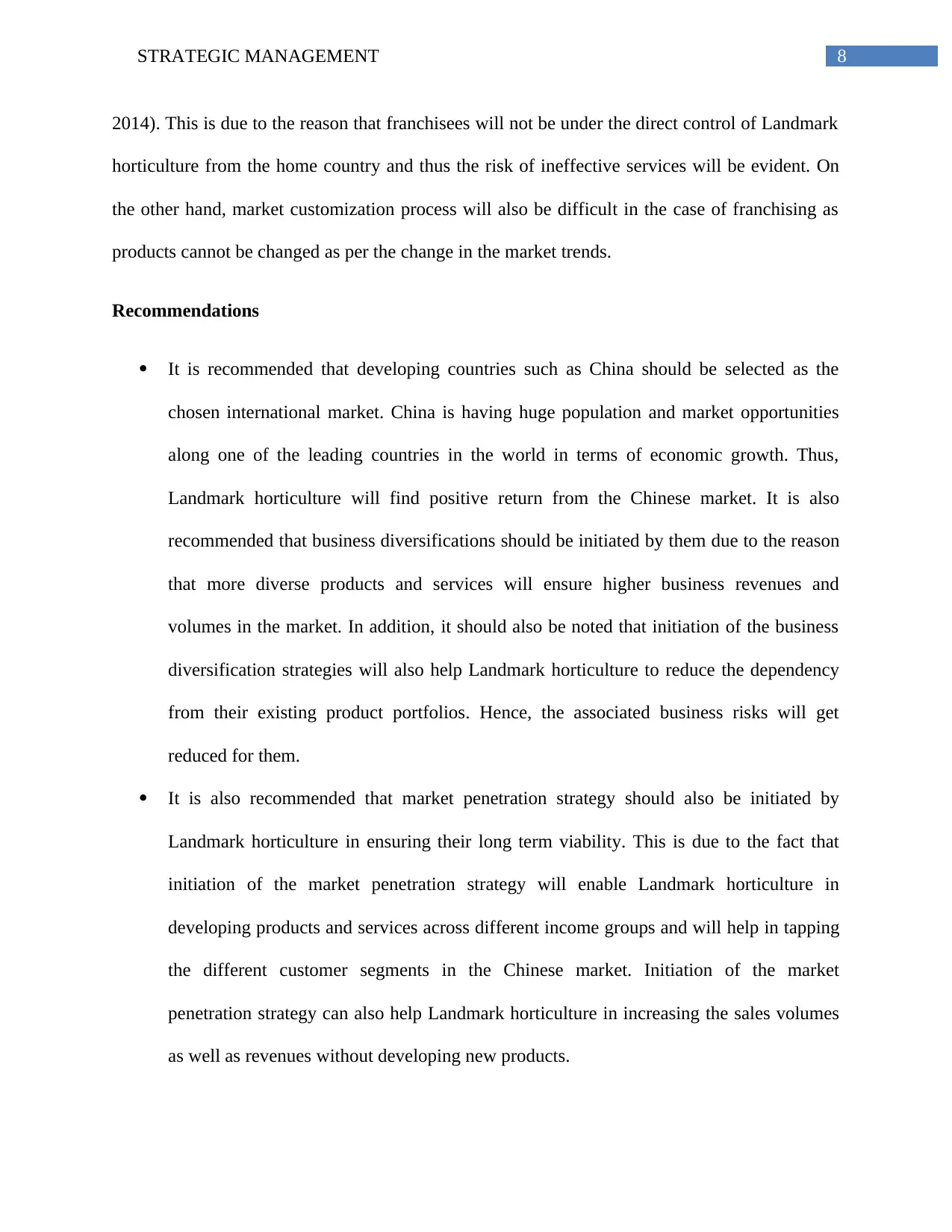
8STRATEGIC MANAGEMENT
2014). This is due to the reason that franchisees will not be under the direct control of Landmark
horticulture from the home country and thus the risk of ineffective services will be evident. On
the other hand, market customization process will also be difficult in the case of franchising as
products cannot be changed as per the change in the market trends.
Recommendations
It is recommended that developing countries such as China should be selected as the
chosen international market. China is having huge population and market opportunities
along one of the leading countries in the world in terms of economic growth. Thus,
Landmark horticulture will find positive return from the Chinese market. It is also
recommended that business diversifications should be initiated by them due to the reason
that more diverse products and services will ensure higher business revenues and
volumes in the market. In addition, it should also be noted that initiation of the business
diversification strategies will also help Landmark horticulture to reduce the dependency
from their existing product portfolios. Hence, the associated business risks will get
reduced for them.
It is also recommended that market penetration strategy should also be initiated by
Landmark horticulture in ensuring their long term viability. This is due to the fact that
initiation of the market penetration strategy will enable Landmark horticulture in
developing products and services across different income groups and will help in tapping
the different customer segments in the Chinese market. Initiation of the market
penetration strategy can also help Landmark horticulture in increasing the sales volumes
as well as revenues without developing new products.
2014). This is due to the reason that franchisees will not be under the direct control of Landmark
horticulture from the home country and thus the risk of ineffective services will be evident. On
the other hand, market customization process will also be difficult in the case of franchising as
products cannot be changed as per the change in the market trends.
Recommendations
It is recommended that developing countries such as China should be selected as the
chosen international market. China is having huge population and market opportunities
along one of the leading countries in the world in terms of economic growth. Thus,
Landmark horticulture will find positive return from the Chinese market. It is also
recommended that business diversifications should be initiated by them due to the reason
that more diverse products and services will ensure higher business revenues and
volumes in the market. In addition, it should also be noted that initiation of the business
diversification strategies will also help Landmark horticulture to reduce the dependency
from their existing product portfolios. Hence, the associated business risks will get
reduced for them.
It is also recommended that market penetration strategy should also be initiated by
Landmark horticulture in ensuring their long term viability. This is due to the fact that
initiation of the market penetration strategy will enable Landmark horticulture in
developing products and services across different income groups and will help in tapping
the different customer segments in the Chinese market. Initiation of the market
penetration strategy can also help Landmark horticulture in increasing the sales volumes
as well as revenues without developing new products.
⊘ This is a preview!⊘
Do you want full access?
Subscribe today to unlock all pages.

Trusted by 1+ million students worldwide
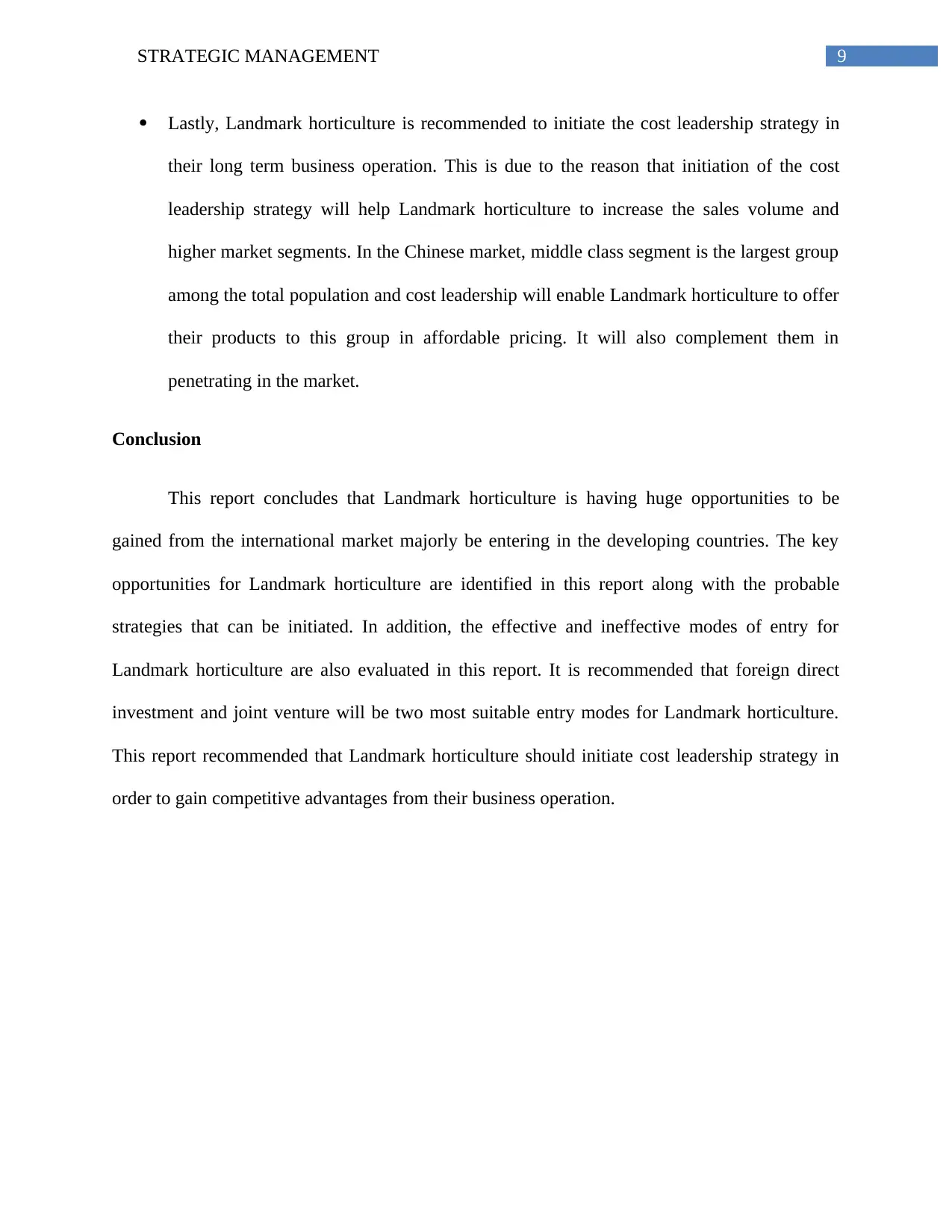
9STRATEGIC MANAGEMENT
Lastly, Landmark horticulture is recommended to initiate the cost leadership strategy in
their long term business operation. This is due to the reason that initiation of the cost
leadership strategy will help Landmark horticulture to increase the sales volume and
higher market segments. In the Chinese market, middle class segment is the largest group
among the total population and cost leadership will enable Landmark horticulture to offer
their products to this group in affordable pricing. It will also complement them in
penetrating in the market.
Conclusion
This report concludes that Landmark horticulture is having huge opportunities to be
gained from the international market majorly be entering in the developing countries. The key
opportunities for Landmark horticulture are identified in this report along with the probable
strategies that can be initiated. In addition, the effective and ineffective modes of entry for
Landmark horticulture are also evaluated in this report. It is recommended that foreign direct
investment and joint venture will be two most suitable entry modes for Landmark horticulture.
This report recommended that Landmark horticulture should initiate cost leadership strategy in
order to gain competitive advantages from their business operation.
Lastly, Landmark horticulture is recommended to initiate the cost leadership strategy in
their long term business operation. This is due to the reason that initiation of the cost
leadership strategy will help Landmark horticulture to increase the sales volume and
higher market segments. In the Chinese market, middle class segment is the largest group
among the total population and cost leadership will enable Landmark horticulture to offer
their products to this group in affordable pricing. It will also complement them in
penetrating in the market.
Conclusion
This report concludes that Landmark horticulture is having huge opportunities to be
gained from the international market majorly be entering in the developing countries. The key
opportunities for Landmark horticulture are identified in this report along with the probable
strategies that can be initiated. In addition, the effective and ineffective modes of entry for
Landmark horticulture are also evaluated in this report. It is recommended that foreign direct
investment and joint venture will be two most suitable entry modes for Landmark horticulture.
This report recommended that Landmark horticulture should initiate cost leadership strategy in
order to gain competitive advantages from their business operation.
Paraphrase This Document
Need a fresh take? Get an instant paraphrase of this document with our AI Paraphraser
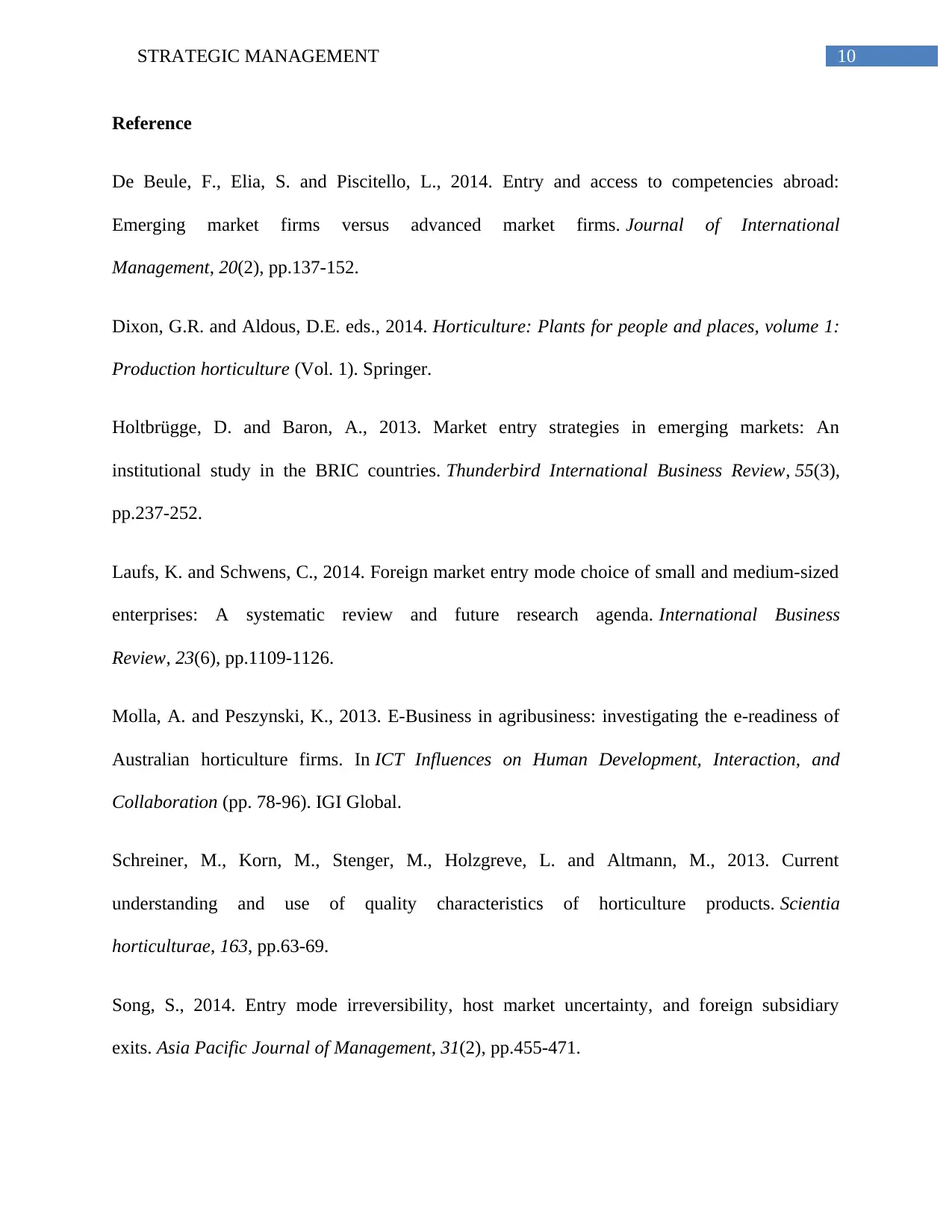
10STRATEGIC MANAGEMENT
Reference
De Beule, F., Elia, S. and Piscitello, L., 2014. Entry and access to competencies abroad:
Emerging market firms versus advanced market firms. Journal of International
Management, 20(2), pp.137-152.
Dixon, G.R. and Aldous, D.E. eds., 2014. Horticulture: Plants for people and places, volume 1:
Production horticulture (Vol. 1). Springer.
Holtbrügge, D. and Baron, A., 2013. Market entry strategies in emerging markets: An
institutional study in the BRIC countries. Thunderbird International Business Review, 55(3),
pp.237-252.
Laufs, K. and Schwens, C., 2014. Foreign market entry mode choice of small and medium-sized
enterprises: A systematic review and future research agenda. International Business
Review, 23(6), pp.1109-1126.
Molla, A. and Peszynski, K., 2013. E-Business in agribusiness: investigating the e-readiness of
Australian horticulture firms. In ICT Influences on Human Development, Interaction, and
Collaboration (pp. 78-96). IGI Global.
Schreiner, M., Korn, M., Stenger, M., Holzgreve, L. and Altmann, M., 2013. Current
understanding and use of quality characteristics of horticulture products. Scientia
horticulturae, 163, pp.63-69.
Song, S., 2014. Entry mode irreversibility, host market uncertainty, and foreign subsidiary
exits. Asia Pacific Journal of Management, 31(2), pp.455-471.
Reference
De Beule, F., Elia, S. and Piscitello, L., 2014. Entry and access to competencies abroad:
Emerging market firms versus advanced market firms. Journal of International
Management, 20(2), pp.137-152.
Dixon, G.R. and Aldous, D.E. eds., 2014. Horticulture: Plants for people and places, volume 1:
Production horticulture (Vol. 1). Springer.
Holtbrügge, D. and Baron, A., 2013. Market entry strategies in emerging markets: An
institutional study in the BRIC countries. Thunderbird International Business Review, 55(3),
pp.237-252.
Laufs, K. and Schwens, C., 2014. Foreign market entry mode choice of small and medium-sized
enterprises: A systematic review and future research agenda. International Business
Review, 23(6), pp.1109-1126.
Molla, A. and Peszynski, K., 2013. E-Business in agribusiness: investigating the e-readiness of
Australian horticulture firms. In ICT Influences on Human Development, Interaction, and
Collaboration (pp. 78-96). IGI Global.
Schreiner, M., Korn, M., Stenger, M., Holzgreve, L. and Altmann, M., 2013. Current
understanding and use of quality characteristics of horticulture products. Scientia
horticulturae, 163, pp.63-69.
Song, S., 2014. Entry mode irreversibility, host market uncertainty, and foreign subsidiary
exits. Asia Pacific Journal of Management, 31(2), pp.455-471.
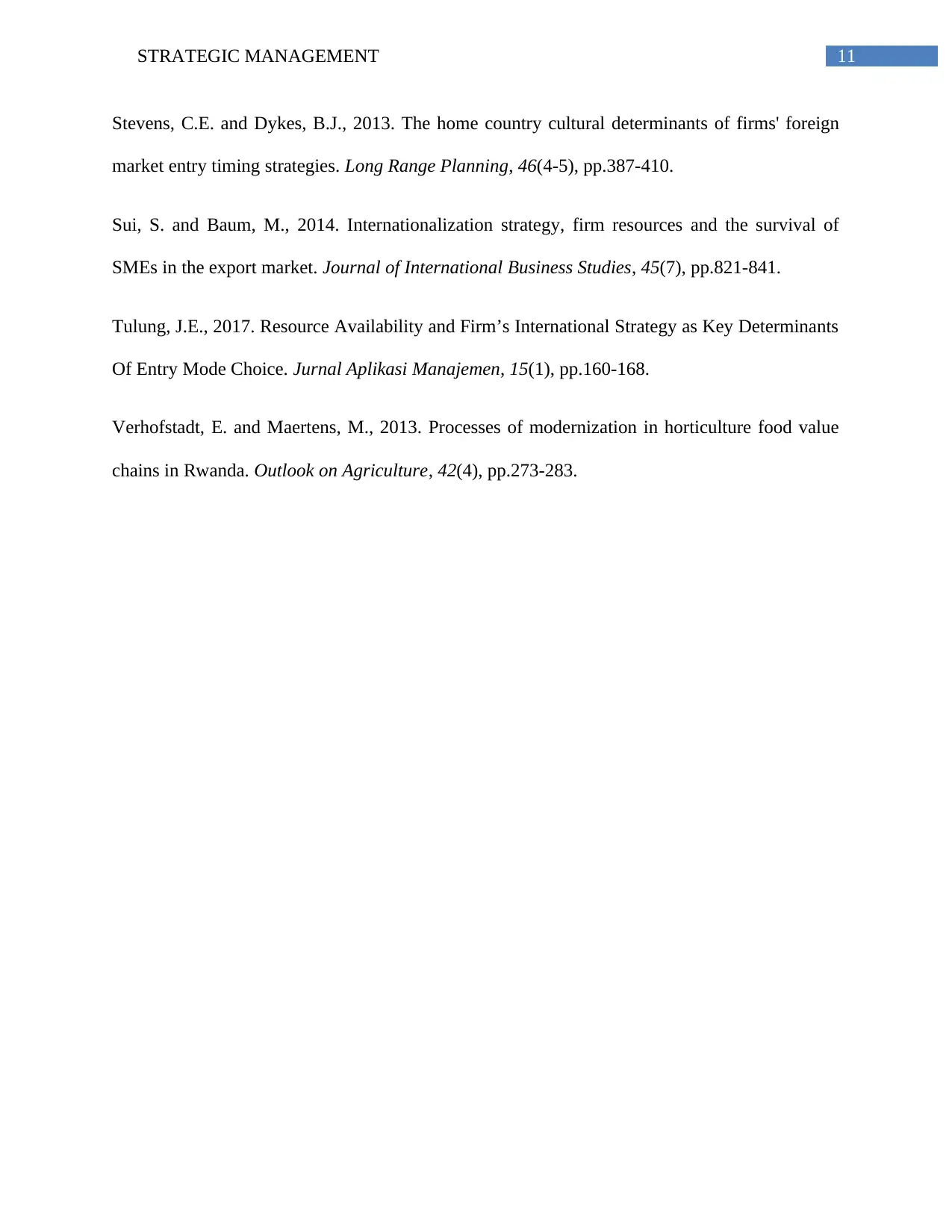
11STRATEGIC MANAGEMENT
Stevens, C.E. and Dykes, B.J., 2013. The home country cultural determinants of firms' foreign
market entry timing strategies. Long Range Planning, 46(4-5), pp.387-410.
Sui, S. and Baum, M., 2014. Internationalization strategy, firm resources and the survival of
SMEs in the export market. Journal of International Business Studies, 45(7), pp.821-841.
Tulung, J.E., 2017. Resource Availability and Firm’s International Strategy as Key Determinants
Of Entry Mode Choice. Jurnal Aplikasi Manajemen, 15(1), pp.160-168.
Verhofstadt, E. and Maertens, M., 2013. Processes of modernization in horticulture food value
chains in Rwanda. Outlook on Agriculture, 42(4), pp.273-283.
Stevens, C.E. and Dykes, B.J., 2013. The home country cultural determinants of firms' foreign
market entry timing strategies. Long Range Planning, 46(4-5), pp.387-410.
Sui, S. and Baum, M., 2014. Internationalization strategy, firm resources and the survival of
SMEs in the export market. Journal of International Business Studies, 45(7), pp.821-841.
Tulung, J.E., 2017. Resource Availability and Firm’s International Strategy as Key Determinants
Of Entry Mode Choice. Jurnal Aplikasi Manajemen, 15(1), pp.160-168.
Verhofstadt, E. and Maertens, M., 2013. Processes of modernization in horticulture food value
chains in Rwanda. Outlook on Agriculture, 42(4), pp.273-283.
⊘ This is a preview!⊘
Do you want full access?
Subscribe today to unlock all pages.

Trusted by 1+ million students worldwide
1 out of 12
Related Documents
Your All-in-One AI-Powered Toolkit for Academic Success.
+13062052269
info@desklib.com
Available 24*7 on WhatsApp / Email
![[object Object]](/_next/static/media/star-bottom.7253800d.svg)
Unlock your academic potential
Copyright © 2020–2025 A2Z Services. All Rights Reserved. Developed and managed by ZUCOL.





